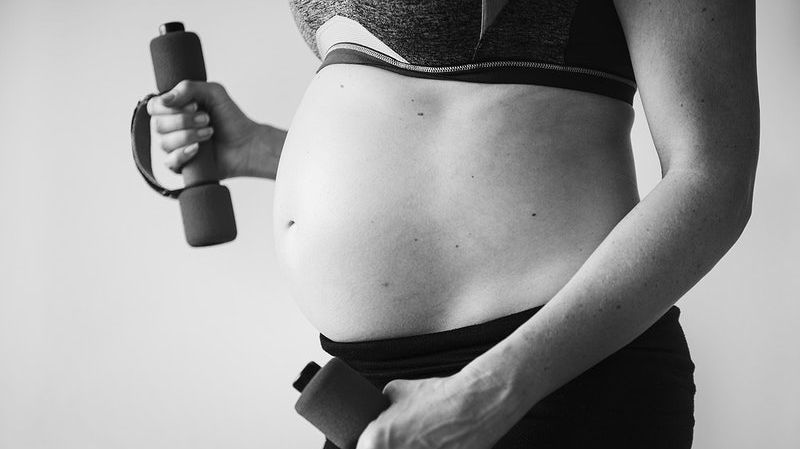Exercise

Unless a health care provider (HCP) has deemed otherwise, exercise is not only safe during pregnancy, but highly recommended.
Although data is somewhat limited based on pregnancy-specific research hurdles, exercise offers many physical and mental health benefits and is well tolerated by the fetus – to include regular moderate and high intensity exercise.
Women with uncomplicated, healthy pregnancies are advised to continue exercising as they did prior to pregnancy, and in women with no history of exercise, they should start with walking, and gradually increase their intensity level as they feel comfortable, under the direction of their HCP.
Women should be cleared prior to beginning a formal exercise regimen and talk to their HCP about any risk factors or underlying health conditions at their first prenatal appointment. Some women may have certain health conditions or risk factors that may preclude their ability to exercise.
Background
Specific evidence-based recommendations on exercise during pregnancy are lacking due to difficulty in measuring accurate results. However, research has improved significantly over the past 50 years with overwhelming positive conclusions on not only the safety of exercise during pregnancy, but the enormous health benefits for bhoth mother and baby.
Exercise during pregnancy – even at intense levels – has not been shown to be harmful, to include an increased risk of miscarriage, low birth weight, birth defects, or early delivery (in otherwise uncomplicated pregnancies).
Despite the proven benefits of exercise during pregnancy, and the lack of evidence indicating it is harmful, the number of women meeting exercise guidelines continues to decrease. It is estimated that only 40% of women exercise during pregnancy, and only 15% meet the minimum national recommendations.
Numerous studies have surveyed women regarding their lack of exercise during pregnancy; reasons given for not exercising included:
Embarrassment related to appearance
Safety concerns (miscarriage)
Concern about injury
Lack of or incorrect information from HCPs
Discomfort
Sense of insecurity
Being too busy

Prior Thought
Women are often hesitant to exercise during pregnancy due to safety concerns, especially in the first trimester. Traditionally, exercise was advised with caution or not recommended for pregnant women to safeguard the health of both the mother and fetus, for the prevention of preterm labor and delivery, and to prevent infants from being born too small.
Prior thought indicated that exercise might shift oxygenated blood and nutrients away from the fetus to the mother, and could increase core body temperature too high and/or too quickly, potentially causing birth defects.
Hormonal changes during pregnancy do increase joint laxity and pose a risk of injury, although this depends on the exercise. Women should choose carefully the type of exercise they wish to perform; there are many low-impact options. Women need to feel comfortable and physically stable during any period of physical activity.
Research Hurdles
Research has significantly improved since recommendations to avoid exercise during pregnancy became pervasive. Exercise is not only much safer than once thought, but not exercising could potentially be more harmful. Still – exact recommendations are numerous and confusing, mostly due to limitations in studying exercise during pregnancy.
It is difficult to obtain accurate estimates of maternal and fetal oxygen intake, blood flow, and heart rate, especially since these responses to physical exercise change dramatically during pregnancy and are highly variable even without exercise. Further, it is considered unethical to both prevent women from doing exercise during their pregnancies, as well as testing pregnant women under strenuous exercise conditions.
Heart rate monitors (including smart watches) are not accurate during pregnancy as heart rate is extremely variable and affected by numerous factors other than physical activity; therefore, target heart rate responses to exercise during pregnancy cannot be established.
These monitors can also be difficult and uncomfortable to wear with larger breasts and an enlarged uterus, both of which can shift around the monitor. Pedometers have been used in some prenatal studies, but they are limited in analysis, and do not differentiate intensity.
Several studies have attempted to assess umbilical cord blood flow during maternal exercise with Doppler velocimetry, but this is very difficult to accomplish during exercise. Instead, measurements were taken before and after exercise, the time in which the factors needed for accurate analysis could have changed, and the most important assessment is during exercise.
Based on this, HCPs are often reluctant to make recommendations about how to promote an increase in physical activity to pregnant women:
Two studies (2004 and 2006) indicated that HCPs were hesitant to advise sedentary women to initiate exercise during pregnancy, and nearly half counseled women to reduce activity, likely due to a lack of solid and consistent guidelines.
Benefits
A more contemporary view of exercise during pregnancy emphasizes that women and their HCPs need to consider the risks of not participating in regular physical activity during pregnancy.

Current research – even with its limitations – has revealed that regular exercise during pregnancy:
Physical
Leads to appropriate maternal and fetal weight gain
Promotes muscle tone, strength, and endurance
May help control blood pressure and prevent hypertension
May help prevent urinary incontinence through increased muscle tone
May help prevent deep vein thrombosis and varicose veins through increased/better circulation
Promotes healthy placental growth, likely through improved blood and oxygen circulation
Reduces back pain and pelvic girdle pain by improving muscle tone and strengthening flexible joints
Eases constipation and bloating by speeding up digestion
Reduces/prevents swelling in ankles, legs, and feet through fluid regulation
Placenta Health: A study published in March 2021 revealed that exercise during pregnancy appears to lead to better blood vessel development in the placenta (and therefore, better nutrient transfer from mother to baby). A group of pregnant women were assigned to mild, moderate, or no exercise, and a sample of their placenta was collected within an hour after delivery.
Researchers analyzed markers of angiogenesis, which indicates formation of new blood vessels (read Preeclampsia for more information on this process) and found a 10-fold increase in the protein expression of angiogenin in the placentas of women who exercised.
Since this marker can also sometimes indicate fetal distress (i.e. the placenta develops more blood vessels to compensate for a lack of oxygen), researchers accounted for this, and found that exercise did not increase placental markers for stress.
Labor and Delivery: Although slightly inconsistent, a regular exercise program may shorten the duration of labor and reduce the risk of cesarean section and assisted delivery (vacuum/forceps), likely due to increased muscle strength and tone, oxygen reserve, and endurance.
Gestational Diabetes Mellitus (GDM): Physical exercise is part of a four-pronged approach to managing gestational diabetes, along with proper diet, monitoring blood sugar levels, and postpartum diabetes screening. Exercise may also decrease a woman’s need for insulin during pregnancy (GDM only). Evidence is less consistent regarding the effect of exercise on the prevention of gestational diabetes, but it may be a protective factor.
Preeclampsia: Although also inconsistent, most studies to date have identified a protective effect of regular exercise on the prevention and management of preeclampsia. Despite this inconsistency, exercise does have beneficial effects on blood pressure and could help women manage their high blood pressure – a risk factor for preeclampsia.
Intensity
There are numerous anecdotal stories of professional athletes and other fit women who have successfully trained under their typical intense training during pregnancy, without complications.
However, based on the hurdles described above, there is a lack of peer-reviewed research regarding this level of intensity during pregnancy, but studies that have been published are reassuring. More interestingly, there is a lack of research indicating it is harmful.
For women who do not exercise at this level, the “talk test” is a frequently recommended tactic of regulating exercise intensity; if a woman cannot hold a conversation while exercising, it has been indicated she is likely exercising too strenuously.
However, the fetus appears to likely tolerate more vigorous exercise than previously thought, especially in healthy, uncomplicated pregnancies. Further – although with limitations – multiple studies have shown that blood flow to the fetus is not significantly altered by moderate-intensity physical activity.
More specifically, several studies of vigorously active pregnant women identified temporary fetal heart rate decelerations as well as altered uterine blood flow. However, changes resolved/reverted to normal immediately after exercise.
Additionally, uterine activity (contractions) during exercise appears to be very minimal, or of very low magnitude, especially late in pregnancy (there is no evidence that exercise helps initiate labor).
This research suggests that pregnant who engaged in regular high-intensity exercise prior to pregnancy can continue the same level of activity during pregnancy.
For moderate intensity exercise, a meta-analysis of over 2,000 women showed that aerobic exercise and strength/toning exercise of moderate intensity performed 3 to 4 days per week was not associated with an increased risk for preterm birth or low birth weight in uncomplicated pregnancies.

A separate concern of high intensity exercise is the possibility of hyperthermia (prolonged heat exposure). Exercise in hot conditions with inadequate fluid replacement is associated with reduced stroke volume and cardiac output, decreases in blood pressure, and reduced blood flow to muscle. It is theorized this could also lead to a decrease in blood flow to the uterus, fetus, and/or placenta as well.
High body temperature can lead to adverse outcomes in pregnancy (regardless of hydration) and it is currently assessed that this threshold is 39 °C/102.2 °F (read more).
Fortunately, of the limited studies conducted so far, there is no data suggesting that women exercise hard or long enough to cause significant hyperthermic effects during pregnancy. However, the risk for hyperthermia increases if women exercise in warm environments (i.e. no ventilation, high outdoor temperature, hot yoga) without adequate hydration.
A study published in June 2021 provides evidence that individuals in their second and third trimester of pregnancy are not at greater risk for hyperthermia during moderate exercise in the heat (45 minutes, 32 °C/89.6 °F). Although pregnant women felt hotter, their body temperatures and sweat output were not different than the control group; core temperature of all pregnant participants never exceeded 38 °C/100.4 °F.
Of note, however, it is possible that higher intensity exercise, or shorter bouts of high intensity exercises in a climate above 32 °C/89.6 °F (or with higher humidity), could raise body temperature higher than observed in this study. Further, this study size was small and body temperature can vary widely among different individuals.
Therefore, although current research is positive regarding intense exercise, there is still a gap regarding an upper limit of intensity and at which point (heart rate, respiratory rate, ambient temperature) harmful effects may begin to appear.
It is also unclear what effects may be different in women who did not engage in intense physical activity prior to pregnancy, but attempt to do so during pregnancy. It is often recommended that women begin exercising as they normally would, and gradually increase intensity if they wish, under the care and direction of their HCP.
Aerobic
Aerobic (cardio) exercise is considered the most beneficial as it uses large muscle groups repetitively for a sustained amount of time. These exercises include cycling, walking, jogging, ellipticals, swimming, aerobic dance, stair climbers, and yoga. Further, lower impact forms of aerobic exercise keep at least one foot on the ground, which lowers the risk of falling.
Walking is a safe total body workout that almost any fitness level can achieve and does not strain joints and muscles.
Jogging is also safe, especially if a pregnant woman jogged regularly before pregnancy; as pregnancy progresses, women may need supportive garments, shoes, and bras for additional comfort as the uterus/breasts get larger.
Swimming is a popular and safe, full body exercise; no negative effects have been reported during pregnancy. Swimming relieves pressure on the joints, decreases the risk of injury, releases women from the burden of additional weight, increases circulation, and decreases swelling.
Cycling is also a popular form of exercise but is slightly riskier during pregnancy due to balance concerns from a growing uterus and shift in center of gravity; a stationary bike can relieve balance concerns but can also be slightly uncomfortable as pregnancy progresses.
There is no evidence that riding a bike harms a pregnancy, but it can irritate the vagina due to increased blood flow, contact irritation, and possible swelling. Outdoor cycling also poses a risk of falling, thereby leading to possible trauma.
Strength/Resistance Training
Studies regarding the safety and benefits of strength training during pregnancy are limited, but it appears to be very beneficial to improve muscle strength and endurance. Light strength training has not been shown to pose a risk to the fetus. Free lifting is easier toward the end of pregnancy, as the abdomen may get too large for certain machines. Women should always talk to their HCP prior to any heavy lifting.
Additional benefits of strength training during pregnancy include overall body strength, improved core strengthening, improved posture, stronger pelvic floor muscles, and better tolerance of labor pain.

A study published in March 2021 investigated whether the Valsalva maneuver (bearing down/lifting) may increase maternal blood pressure and intra-abdominal pressure, resulting in decreased blood flow to the fetus during resistance training.
The study concluded that resistance training up to a 1 repetition maximum of 50 pounds (22.7 kg) did not result in a significant reduction of placental blood flow from resting state in the study population.
Yoga and Pilates
Prenatal yoga and Pilates can reduce stress, improve flexibility and stamina, and encourage stretching and focused breathing. Prenatal versions specifically address a pregnant woman’s change in balance and avoids certain poses that require women to lie flat on their backs or abdomens.
Bikram (hot) yoga, is practiced at temperatures of 95° to 104° F (35° to 40° C). While there are no published studies on the safety of hot yoga during pregnancy, based on hyperthermic studies in general, it is best to avoid any environment for exercise that is warmer than 89° F/32° C.
Hydration
An important aspect of physical activity – especially intense exercise – is adequate hydration and electrolyte balance. A lack of hydration during exercise due to fluid loss (sweating) leads to dehydration, a serious complication during pregnancy. This risk further increases with exercise in warmer environments.
Dehydration can lead to serious complications, ranging in severity from mild heat cramps to heat exhaustion or potentially life-threatening heatstroke.
Thirst is not the best predictor of dehydration and pregnant women need to make sure they are drinking enough fluids during and after exercise depending on their level of exertion and fluid loss; extra water is needed in both warmer and colder environments, as well as high altitude.

It is also possible to drink too much water on top of losing too much fluid through sweat. Known as hyponatremia, it is caused by electrolyte loss/dilution from sweating, which is then worsened further by drinking plain water.
Symptoms of hyponatremia include nausea, vomiting and headache; severe cases may also include seizures, coma, swelling of the brain, and in rare cases, death. Women who sweat a lot during exercise should consider drinking sports drinks that contain electrolytes, avoiding low blood sugar by eating properly, and/or cutting back on intensity if necessary.
General guidelines
Various organizations around the world agree, that in the absence of medical or obstetric complications, pregnant women should exercise at a moderate level for 30 or more minutes per day on most, if not all days of the week.
Most current recommendations also state that women should be encouraged to exercise in the same manner they did prior to pregnancy, to include those who engaged in high-intensity exercise.
However, exercise does not have to be intense to be beneficial. Women with no formal or regular exercise routine prior to pregnancy are recommended to begin a light exercise program and adjust gradually every week or at the recommendation of their HCP.
All pregnant women should talk to their HCP regarding exercise at their first prenatal appointment. The HCP will perform an overall assessment of the woman’s health, identify any risk factors or potential complications, and recommend guidelines specific to that woman’s pregnancy.
Healthy women with no complications are considered low risk regardless of previous activity level, whereas women with certain chronic medical conditions are considered high risk.
Avoid
General recommendations also include certain specific exercises and activities that pregnant women should routinely avoid, which include:
Any contact sport in which a woman could get hit in the abdomen by someone else or through force (ice hockey, boxing, soccer, softball, surfing, water skiing, or basketball).
Any activity that has a lot of jerking, bouncing movements, or increases the risk of falling (horseback riding, downhill skiing, off-road cycling, gymnastics, trampoline jumping, and skating).
Exercising at high altitude unless the woman already lives at high altitude or has allowed enough time for the acclimatization process upon visiting a high altitude location.
Scuba diving, which can lead to decompression sickness (gas bubbles form in either the mother's or fetus' body).
Any exercise in which a pregnant woman needs to lie flat on her back, which can cause a significant decrease in blood pressure.
Do NOT Exercise
Pregnant women should not exercise if they were given specific instruction from their HCP.
Although evidence is lacking for some of these risk factors, women may be told to avoid or restrict exercise in the following scenarios (similar to the above described warning signs):
Preterm labor or risk of preterm labor (restriction of exercise is different from bed rest)
Vaginal bleeding is present
Multiple pregnancy (twins, triplets) due to preterm labor risk
Cervical insufficiency or a cerclage
Risk of placenta previa
Cardiac conditions (heart/blood pressure)
Preeclampsia (debated)
Women should talk to their HCP about all underlying health conditions and ask their HCP about potential exercise limitations during their pregnancy.
Postpartum
Postpartum physical activity can improve mood, maintain cardiovascular and respiratory fitness, improve weight control, and reduce levels of fatigue, depression, and anxiety. Postpartum exercise may also help slow bone loss during lactation.
According to the American College of Obstetricians and Gynecologists (ACOG) as of April 2020, "women who habitually engaged in vigorous-intensity aerobic activity or who were physically active before pregnancy can continue these activities...in the postpartum period."
The timing in which women choose to begin exercising postpartum is completely individualized and depends on many factors such as physical activity during pregnancy, overall health, delivery method, and the presence or absence of medical or surgical complications. Some women are capable of resuming physical activities within days of delivery. Women should always speak to their health care provider first to determine recommendations and guidelines for exercising after delivery.

Most international guidelines regarding returning to (or starting) exercise in the postpartum period are very general, and not specific to certain types of exercise. However, recommended physical activities include aerobic, pelvic floor exercise, strengthening, stretching, and walking.
Abdominal Muscles: Abdominal strengthening exercises have been shown to decrease the incidence of diastasis recti abdominus (DRA) and decrease the inter-rectus distance in postpartum women.
Overall, the role of postpartum exercise interventions for DRA is understudied, but specific, appropriate exercises can improve the condition. Some of these exercises can even be started within days of delivery. Women should talk to their HCP about physical therapy recommendations; a physical therapist can help ensure proper form of exercises so DRA does not worsen.

Pelvic Floor: Results from a clinical trial published in August 2020 suggested women should be encouraged to start general exercise within the first six weeks after giving birth and be encouraged to talk with a physical therapist, especially regarding immediate pelvic exercises.
According to ACOG, pelvic floor exercises can be initiated in the immediate postpartum period and can help prevent certain long-term complications, such as urinary incontinence (UI).
Postpartum moderate to vigorous physical activity can be protective of pelvic floor health as it can strengthen muscles that weakened during pregnancy and delivery.
Women with a history of UI or who experienced UI during pregnancy may be advised to begin a Kegels regimen or be referred to physical therapy. Early and consistent treatment is critical as women with UI three months or longer are at increased risk of having long-term symptoms.
Running: A study published in June 2021 examined factors that contribute to postpartum return-to-running and return to pre-pregnancy running level, as well as risk factors for postpartum running-related stress urinary incontinence (SUI). More than eight hundred postpartum women completed the questionnaire:
Median time to first postpartum run was 12 weeks. The authors concluded that running during pregnancy may assist women safely returning to this same exercise in the postpartum. Fear of movement, the sensation of vaginal heaviness, and running-related SUI before or during pregnancy are common, but women should talk to their HCP early about these concerns.

Lactation: Numerous studies have determined that regular exercise in the postpartum period has no adverse effect on lactation, and does not lessen milk production, change its composition, or affect hormone levels. Further, at least one study indicated exercise may help improve breastfeeding outcomes.
However, it has been advised that women who are lactating should consider feeding their infants or expressing milk before exercising to avoid the potential discomfort of engorged breasts. They also should also make sure they are adequately hydrated prior to, during, and after exercise.
Action
Women should be cleared prior to beginning a formal exercise regimen and talk to their HCP about any risk factors or underlying health conditions at their first prenatal appointment and in the immediate postpartum period. Some women may have certain health conditions or risk factors that may preclude their ability to exercise.
Women with uncomplicated, healthy pregnancies are advised to continue exercising as they did prior to pregnancy, and in women with no history of exercise, they should start with walking, and gradually increase their intensity level as they feel comfortable, under the direction of their HCP.
Women who sweat a lot during exercise need to remain properly hydrated and consider drinking sports drinks that contain electrolytes, avoiding low blood sugar by eating properly, and/or cutting back on intensity if necessary. Women should also avoid exercising in warm environments which could increase the risk of heat-related illness.
Women who wish to exercise at high altitude should read more information and talk to their HCP.
Partners/Support
Women's partner/support can help keep pregnant women safe; they can remind them to stay hydrated, avoid long intense exercise, keep cool, stop exercising when she feels any of the warning signs/symptoms above, and be there in the event she needs any assistance.
Partners and family members can also be motivating. Exercise during pregnancy can be difficult due to various common discomforts, but if women have a partner to appropriately exercise with them, as well as to encourage and support them, they may be more inclined to exercise (even light walking) more often.
Further, it can be safer for pregnant woman to exercise with a partner, who can also help women recognize possible signs of heat stroke or distress (see above).
Resources
Exercise During Pregnancy (American College of Obstetricians and Gynecologists)